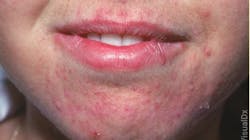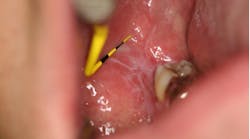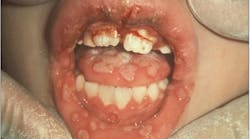Contributing authors
Gary N. Frey, DDS
Cleverick (C.D.) Johnson, DDS, MS
Janet C. Fenske, MS, MLS
Ben F. Warner, DDS, MD, MS
Abstract
Perioral dermatitis is frequently an erythematous skin rash around the mouth that may have a similar appearance to acne.
Introduction
Perioral dermatitis occurs in both light-skinned people and people of color.1 The most common form is described as a rash1 that can have papules, pustules, and/or pink scaly patches surrounding the oral cavity and resembling acne.2 (See image above3) There is also a granulomatous form called facial Afro-Caribbean childhood eruption.2 Dental professionals are well-positioned to observe the clinical features of this condition in their patients.
Etiology of perioral dermatitis
The exact pathophysiology of perioral dermatitis is unclear. A relationship has been established with corticosteroid use and its discontinuation, along with nasal corticosteroid spray, and high fluoride concentration dentifrice of 5000 ppm.
Common medications that may be associated with this skin eruption include topical antibiotics, topical antifungals, topical calcineurin inhibitors, and oral antibiotics.4 Tartar-controlled toothpaste is considered causative in producing perioral dermatitis. Resolution of the lesions is seen after discontinuation of the dentifrice.
Since the lesions are commonly understood to be exacerbated by the use of corticosteroid products as well as their discontinuation,4 it has been postulated that topical steroids affect the microflora of the hair follicle and cause the lesions. Others have proposed that infectious sources, such as Candida albicans, fusiform bacteria, and Demodex mites, are causative agents. Cosmetic products and hormonal factors have been considered in the etiology, as well as the cholinergic system due to its role in neurogenic inflammation.5
Clinical presentation of perioral dermatitis
Perioral dermatitis is prevalent in a wide age range of ages, from children to adults, but is most commonly found in females ages 15 to 25. A common presentation includes an erythematous rash with an acne-type pustule of long duration around the mouth that usually does not involve the vermilion border. Along with a rash, symptoms include possible itching, burning, and flaking of the affected skin areas. The skin around the nose and eyes can also be affected and for this reason is referred to as periorificial dermatitis.5
Treatment and management
Preferred treatment options include topical antibiotic preparations such as metronidazole cream or gel, clindamycin lotion or gel, erythromycin gel, and other topical medications such as tacrolimus ointment.5 Additionally, oral antibiotics metronidazole or erythromycin are effective treatment options.4 On average, resolution of perioral dermatitis takes approximately three months.4
Conclusion
Dental hygienists and dentists are ideally situated to monitor these skin lesions due to the frequency of dental appointments and the long duration of the eruptions. Gathering the medical and dental history allows the dental team to check for new or discontinued medications and the use of over-the-counter products, including certain cosmetics and dentifrices.
Careful observation by dental professionals can afford patient recommendations of referral to medical professionals for treatment and collaborative care.
References
1. Nguyen V, Eichenfield LF. Periorificial dermatitis in children and adolescents. J Amer Acad Derm. 2006;55(5):781-788. doi:10.1016/j.jaad.2006.05.031
2. Lawley LP, Parker SS. Perioral Dermatitis. Access Medicine. Accessed March 27, 2024. https://accessmedicine.mhmedical.com/content.aspx?bookid=392§ionid=41138787
3. Robinson M. Perioral dermatitis: how to spot and treat this common rash. GoodRx. February 23, 2024. https://www.goodrx.com/health-topic/dermatology/perioral-dermatitis
4. Peters P, Drummond C. Perioral dermatitis from high fluoride dentifrice: a case report and review of literature. Austr Dent J. 2013;58:371-372.
5. Tolaymat L, Hall MR. Perioral dermatitis. Updated September 4, 2023. StatPearls https://www.ncbi.nlm.nih.gov/books/NBK525968/
About the Author
Michele White, DDS
Michele White, DDS, is a general dentist and an assistant professor of restorative dentistry at the UTHealth School of Dentistry where she teaches predoctoral dental students in the preclinic simulation laboratory as well as in the dental clinic. She is the course director for the foundational skills for clinic I and II courses that introduce entry-level dental knowledge and skills to first-year dental students. Dr. White provides dental care to patients in the faculty practice at UT Dentists.



